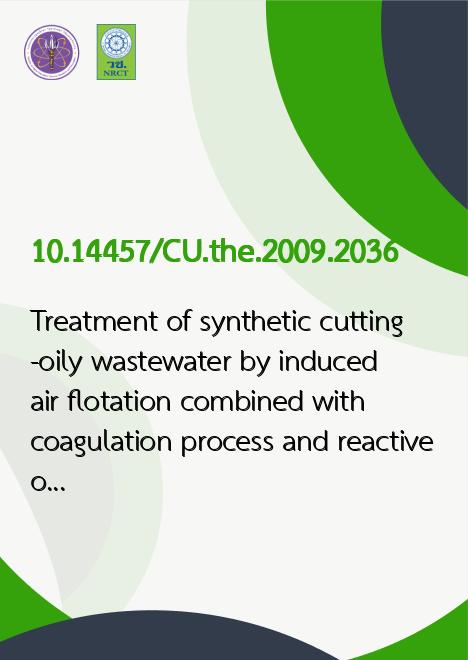
|
Treatment of synthetic cutting-oily wastewater by induced air flotation combined with coagulation process and reactive oil concept |
|---|---|
| รหัสดีโอไอ | |
| Title | Treatment of synthetic cutting-oily wastewater by induced air flotation combined with coagulation process and reactive oil concept |
| Creator | Suraruk Uanyuan |
| Contributor | Pisut Painmanakul |
| Publisher | Chulalongkorn University |
| Publication Year | 2552 |
| Keyword | Sewage -- Purification -- Flotation, Sewage -- Purification -- Coagulation, Oil pollution of water |
| Abstract | To study the treatment efficiency of cutting oily-wastewater by using Induced Air Flotation (IAF) process combined with coagulation process called as Modified Induced Air Flotation (MIAF) and also reactive oily bubble concept. The experiment was conducted in 2 flotation columns; small column with 4.2 cm diameter and large column with 10 cm diameter. The optimal operating condition (gas flow rate, chemical dosage, bubble hydrodynamic and residence time distribution, RTD) were investigated whereby the batch and continuous processes. The results showed that cutting oil-droplet (average size approximately 1.3 µm) cannot be separated by decantation and also caused some limitation to IAF and reactive oily bubble coated with kerosene flotation processes. Concerning to the study of coagulation in jar test, the optimal condition was at an initial pH 7 and 150 mg/L of alum: highest removal efficiency was 91.23%. Note that this condition was then applied further in MIAF process. The treatment efficiencies obtained with small and large columns in batch MIAF process were 94.69% and 82.97%, respectively. The optimal conditions were 150 mg/L of alum dosage and 1.0 L/min of gas flow rate for the small column and 225 mg/L of alum and 2.0 L/min of gas flow rate for large column. Moreover, the treatment of cutting oily-wastewater was independent on a/G ratio related with bubble hydrodynamics and mixing parameters, and thus causes some limitation on oil droplet-bubbles agglomeration. In this work, the chemical destabilization was proven as the important treatment mechanism. Moreover, in continuous process, the treatment efficiencies obtained with small column (80%) were greater than those obtained with large column (25-45%): the difference in terms of momentum force, water recirculation and thus floc breaking phenomena occurred in large column should be responsible for these results. According to RTD experiments, tanks in series model were investigated with small column, while closely to ideal CSTR model were obtained with large column flotation: this can affect negatively the overall treatment efficiencies. In future, the continuous MIAF process with settling reactor or Sequencing Batch Reactors (SBR) should be applied in order to enhance the treatment of cutting oily-wastewater |
| URL Website | cuir.car.chula.ac.th |